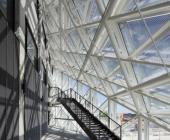Elsinore Culture Yard
In many years the attention has been aimed at the site adjacent, where the UNESCO World Heritage site, Kronborg Castle, which is famous for its role in Shakespeare's Hamlet, exerts its magnetic pull on both tourists and local citizens of Elsinore – but now Elsinore’s old shipbuilding yard has been transformed into a 17.000 m2 cultural and knowledge centre, including concert halls, showrooms, conference rooms, a dockyard museum and a public library.
The Library itself is 6.000 m2
The Culture Yard symbolizes Elsinore’s transformation from an old industrial town to a modern cultural hub. In this way, the yard is designed as a hinge between the past and present, reinforcing the identity of the local community, but at the same time expressing an international attitude, reinforcing the relation between the local and global community.
Title of library in local language
KulturværftetYear of completion
2010Address
Allegade 2
3000 Helsingør
Denmark
Category of library
Public LibraryMore info on the building
http://wikimapia.org/9122952/THE-CULTURE…Awards and recommended reading
- Award for Community or Residential Structures 2011
- The Sheet Metal Prize awarded by the Danish Steel Institute 2011pdf in Danish
- Engineers winn award in Danish
- Transformation of historical shipyard building completes on Elsinore's waterfront
- The contractors' pictures
- de zeen magazine More Pictures
- aart architects' own presentation
Architectural idea or principle
Thanks to architectural features such as wrought iron stairs and concrete elements, interacting with modern glass structures and interior designs, the contrast between the days of the past and the present becomes evident. It is the Culture Yard’s way of playing with the field of tension between old and new, making the notion of past versus present, the industrial society versus the information society, constantly present.
Interior design
AART Architects A/SOverall Cost
€ 44.528.748Detailed description
The contrast between past and present permeates the Culture Yard. For instance, the original concrete skeleton with armoured steel has been reinforced, but left exposed as a reference to the area’s industrial past. The historic context has thus been the main structural idea in the design process, ensuring the keen observer will discover a chapter of history in every corner of the yard and every peeling of the wall. In other words, if you want to understand what Elsinore really is, what the intangible blur between past and present feels like, this is the place to visit.
Particularly striking, when viewed from the seafront and Kronborg Castle, is the multifaceted façade. Like a fragmented, yet strongly coherent structure, the enormous glass and steel façade challenges the historic site and stares unflinchingly across the Sound – the strait that separates Denmark and Sweden. The transparent façade also reinforces the relation between inside and outside, as you can peak in from street level and enjoy the magnificent sea view and view of Kronborg Castle from every floor of the building, especially from the glass cave which in a dramatic gesture protrudes out of the building above the main entrance.
In this way, the façade encloses the yard in a distinctive atmosphere, as the dazzling and dramatic play of lines generates a sense of spaciousness. Although the façade is made of hundreds of lines and triangles it appears as one big volume, generating a sense of place and time. The volume also takes the environment into account, since the façade not only functions as an aesthetic and spatial architectural feature, but also as a climate shield, reducing the energy demand for cooling and heating of the building.
































